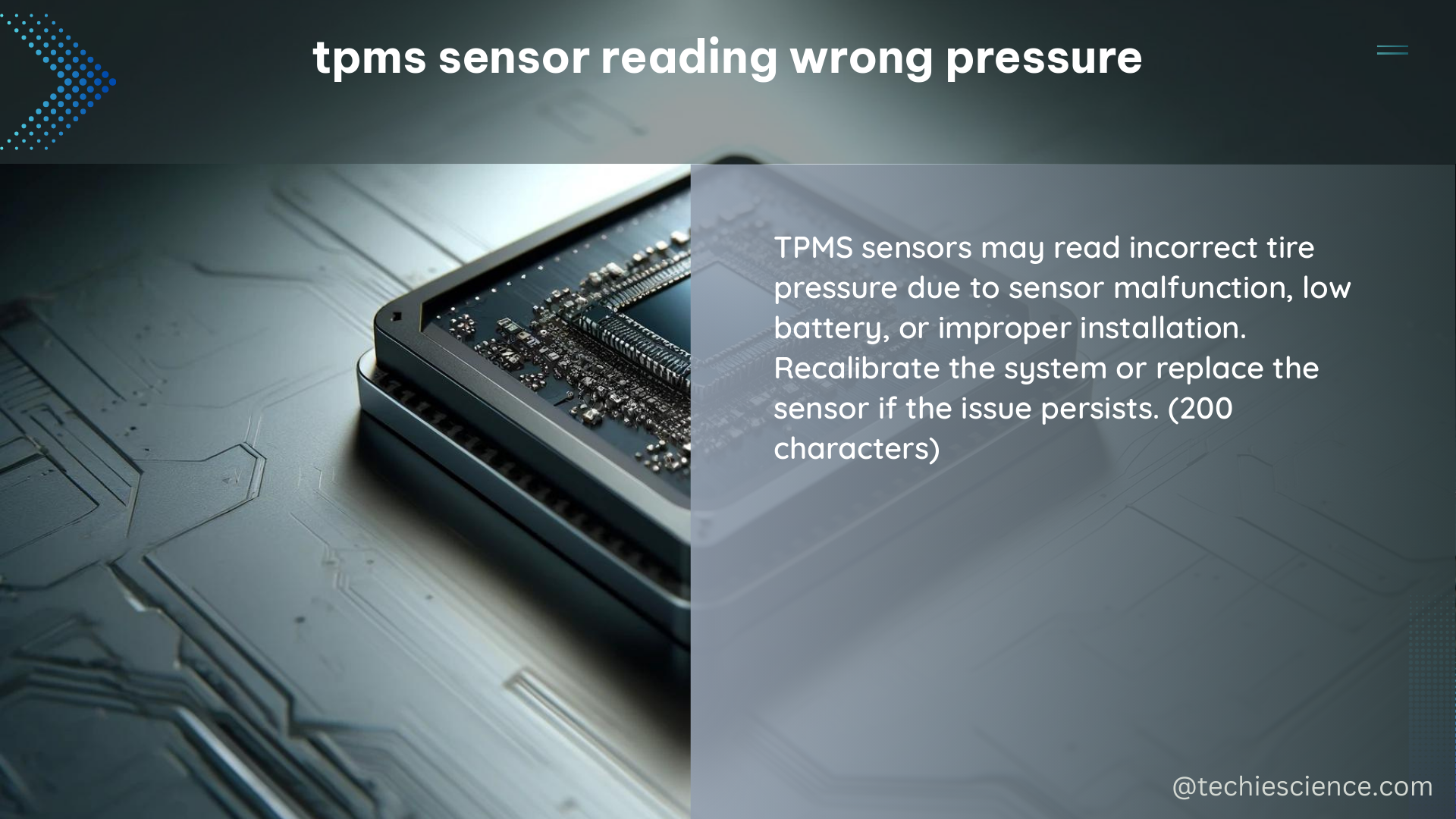TPMS (Tire Pressure Monitoring System) sensors are designed to provide real-time information about tire pressure to ensure safety and fuel efficiency. However, there are instances where TPMS sensors may display inaccurate pressure readings, which can be a source of frustration for vehicle owners. This comprehensive guide will delve into the common issues associated with TPMS sensor readings and provide step-by-step solutions to address them.
Understanding TPMS Sensor Accuracy
TPMS sensors are engineered to provide accurate tire pressure readings, but various factors can contribute to discrepancies between the sensor readings and the actual tire pressure. Let’s explore the common data points that indicate TPMS sensor readings may be incorrect:
-
Pressure Offset: A TPMS sensor may display a pressure reading that is off by as much as 2-3 psi compared to a manual tire pressure gauge. This variation can be attributed to manufacturing tolerances, sensor calibration, or environmental factors.
-
Tire-to-Tire Variation: A TPMS sensor may show a difference of 3 or 4 psi between the readings of the four tires. This disparity may reduce after driving for a while, as the tires equalize in pressure.
-
Significant Pressure Deviation: A TPMS sensor may display a pressure reading that is as much as 5 psi off from the actual pressure, which could be a warranty issue or indicate a problem with the sensor.
-
Consistently Higher Readings: A TPMS sensor may display a pressure reading that is consistently higher than the actual pressure, which could be due to manufacturing tolerances or other factors.
-
Temperature Sensitivity: A TPMS sensor may display a pressure reading that is affected by temperature changes, with readings being more accurate when the tires are cold.
Understanding these data points is crucial in identifying and addressing TPMS sensor reading issues.
Troubleshooting TPMS Sensor Readings

When faced with TPMS sensor readings that are inaccurate, there are several steps you can take to troubleshoot and resolve the problem. Let’s dive into the details:
1. TPMS Sensor Relearning
One of the first steps in addressing TPMS sensor reading issues is to relearn the sensors to ensure they are correctly paired with the vehicle’s ECU (Electronic Control Unit). This process typically involves the following steps:
- Locate the TPMS relearn procedure in the vehicle’s owner’s manual or service information.
- Use a TPMS relearn tool or follow the manufacturer’s recommended procedure to initiate the relearn process.
- Ensure that all TPMS sensors are properly identified and paired with the correct wheel positions.
- Verify the TPMS sensor readings after the relearn process is complete.
2. TPMS Sensor Inspection and Replacement
If the TPMS sensor readings are still inaccurate after the relearning process, it’s essential to inspect the sensors for any signs of damage or wear. Common issues that can affect TPMS sensor performance include:
- Sensor damage: Check for physical damage, such as cracks, dents, or corrosion, that may compromise the sensor’s functionality.
- Sensor battery life: TPMS sensors are powered by batteries, which have a limited lifespan. Replace the sensors if the battery is depleted.
- Sensor calibration: Ensure that the TPMS sensors are properly calibrated to the vehicle’s specifications.
If any of the TPMS sensors are found to be faulty, it’s recommended to replace them with new, compatible sensors to restore accurate pressure readings.
3. TPMS Sensor Calibration
In some cases, the TPMS sensors may require calibration to ensure they are providing accurate pressure readings. This process typically involves the use of a scan tool or other specialized equipment. The steps for TPMS sensor calibration may vary depending on the vehicle make and model, but generally include:
- Connecting the scan tool to the vehicle’s diagnostic port.
- Accessing the TPMS calibration menu or function.
- Following the on-screen instructions to initiate the calibration process.
- Verifying the TPMS sensor readings after the calibration is complete.
It’s important to follow the manufacturer’s recommended calibration procedures to ensure the TPMS sensors are properly configured for your vehicle.
4. Manual Tire Pressure Verification
In addition to troubleshooting the TPMS sensors, it’s essential to verify the actual tire pressure using a high-quality tire pressure gauge. This step can help identify any discrepancies between the TPMS sensor readings and the real-time tire pressure. If the manual tire pressure measurements differ significantly from the TPMS readings, you may need to adjust the tire pressure accordingly.
5. Consulting the Owner’s Manual and Seeking Professional Assistance
If you’ve followed the steps above and are still experiencing issues with TPMS sensor readings, it’s recommended to consult the vehicle’s owner’s manual for additional troubleshooting guidance. If the problem persists, it’s advisable to seek the assistance of a qualified automotive technician who can further diagnose and address the TPMS sensor issues.
Conclusion
TPMS sensor readings that are inaccurate can be a frustrating problem for vehicle owners, but with the right troubleshooting steps, you can effectively address the issue and restore accurate tire pressure monitoring. By understanding the common data points associated with TPMS sensor reading errors, relearning the sensors, inspecting and replacing faulty components, calibrating the sensors, and verifying the tire pressure manually, you can ensure your TPMS system is functioning correctly and providing reliable information to keep your vehicle safe and fuel-efficient.
References:
– One TPMS Reading Low But Tire Pressure is Actually Fine
– New TPMS Sensor Readings Do Not Match Manual Tire Gauge
– TPMS False Reading
– Tire Pressure Sensors in Wrong Tires
– Can TPMS be Calibrated if Reading Too High PSI?

The lambdageeks.com Core SME Team is a group of experienced subject matter experts from diverse scientific and technical fields including Physics, Chemistry, Technology,Electronics & Electrical Engineering, Automotive, Mechanical Engineering. Our team collaborates to create high-quality, well-researched articles on a wide range of science and technology topics for the lambdageeks.com website.
All Our Senior SME are having more than 7 Years of experience in the respective fields . They are either Working Industry Professionals or assocaited With different Universities. Refer Our Authors Page to get to know About our Core SMEs.